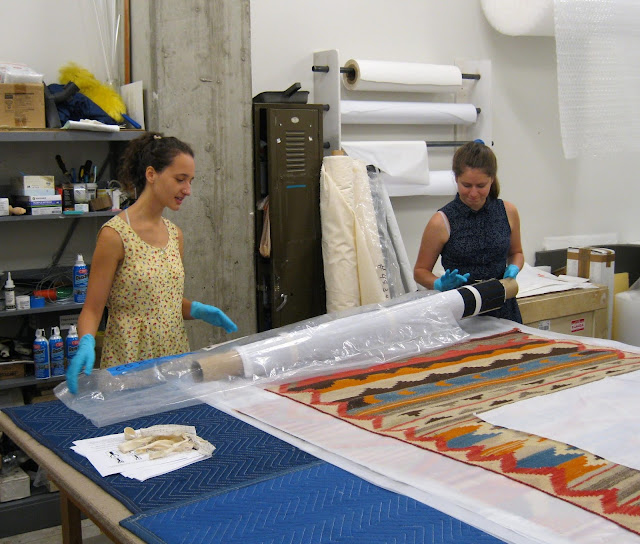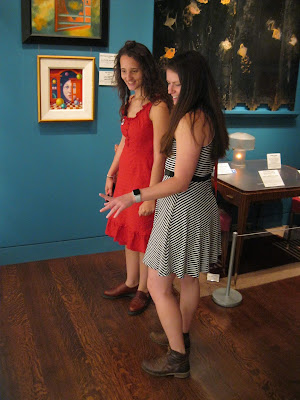Stories in Yarn
Last week, on July 5th, Jeanne Steiner's block B summer weaving class popped in for a visit to the FAC to admire seven textiles from our collection. The invitation had been in place for quite a while, and over the previous couple of weeks, we were tasked with learning proper textile handling methods, investigating weaving techniques and traditions of the American Southwest, and researching specific information pertaining to the seven textiles. Upon gathering this information, we organized a presentation for Jeanne's weaving students.
Earlier in the summer we had invited Jeanne to come meet with us about what she would like us to share with the class and she encouraged us to basically talk their ears off. So that's what we did.
We prepared for our talkathon through a variety of processes. First, we located and pulled each individual textile to get a better sense of the pieces themselves. To gather basic details such as the textile's locality, date, collector, donor, etc., we also pulled each of their card files from our archives. Since our online collections database did not have updated, color images of these pieces, we set up a standard photo booth and shot each textile.
The next part of our preparation was fully research based. We would like to send a shout out to Joe Ben Wheat. Joe Ben Wheat (1916-1997) was an archaeologist and anthropologist who we like to call "the expert" on American Southwest weaving. His textbook, Blanket Weaving in the Southwest, is the source for the bulk of our research. During his career, Wheat specialized in this field, and earned a reputation as an authority on weaving of the Southwest. This textbook explores the development of Southwestern textiles from the early historic period to the late nineteenth century, traces significant changes in materials, techniques, and designs, and establishes an important classification scheme for Navajo, Pueblo, and Spanish American textiles. Thank you, Joe Ben Wheat. We could not have done this without you.
Along with learning a great deal about weaving, we also learned an incredible amount of American Southwest history throughout this research process. Here is an example of the kind of information we uncovered and shared with Jeanne's class:
Out of the seven textiles we presented, two of them are classified as "slave" or "servant" blankets. The image above is a slave blanket dating back to 1880. To clarify the term, "slave" blanket: the Spanish entered the American Southwest around 1540. Over the centuries, many Navajo and Pueblo people were captured in slaving expeditions and held by Spanish masters. Weaving was one of the tasks to be carried out by slave women. They used their own upright looms, but were confined to the synthetic dyes favored by and only available to the Rio Grande Valley (Northern New Mexico). Naturally, Spanish design elements began to appear in these textiles. The meaning of the term “slave blanket” has become quite muddled over the years: it was originally used to denote a blanket woven by a Navajo or Pueblo slave in a Spanish-American household. However, it has also commonly been used to describe blankets resembling this specific style: textiles woven on an upright loom, having a number of Spanish-American characteristics, and containing the dyes characteristic to the Rio Grande Valley.
Our research showed us that each textile is a piece of tangible history of the American Southwest. Through their patterns, dyes, and materials, they tell a story of deep-rooted traditions, and serve as evidence of cross-cultural interactions.
Here are some of the other textiles we presented on:
We learned so much through this research process, furthered our art handling abilities, and got a taste of what it was like to be a teacher for an hour (not so bad!). It was especially rewarding to be able to share all that we have learned with Jeanne's class, and to see the class's reaction to each textile. This was a wonderful experience.
P.S. Jeanne and weaver protégés, if you're reading this, thank you for coming!
Considered blog titles:
- Let's Do the Time Warp Again
- Un-be-weave-able
- Be-weave in Joe Ben Wheat
- Be-weave Us, We Researched
- No Tiger Weft Behind
Earlier in the summer we had invited Jeanne to come meet with us about what she would like us to share with the class and she encouraged us to basically talk their ears off. So that's what we did.
We prepared for our talkathon through a variety of processes. First, we located and pulled each individual textile to get a better sense of the pieces themselves. To gather basic details such as the textile's locality, date, collector, donor, etc., we also pulled each of their card files from our archives. Since our online collections database did not have updated, color images of these pieces, we set up a standard photo booth and shot each textile.
The next part of our preparation was fully research based. We would like to send a shout out to Joe Ben Wheat. Joe Ben Wheat (1916-1997) was an archaeologist and anthropologist who we like to call "the expert" on American Southwest weaving. His textbook, Blanket Weaving in the Southwest, is the source for the bulk of our research. During his career, Wheat specialized in this field, and earned a reputation as an authority on weaving of the Southwest. This textbook explores the development of Southwestern textiles from the early historic period to the late nineteenth century, traces significant changes in materials, techniques, and designs, and establishes an important classification scheme for Navajo, Pueblo, and Spanish American textiles. Thank you, Joe Ben Wheat. We could not have done this without you.
Along with learning a great deal about weaving, we also learned an incredible amount of American Southwest history throughout this research process. Here is an example of the kind of information we uncovered and shared with Jeanne's class:
Out of the seven textiles we presented, two of them are classified as "slave" or "servant" blankets. The image above is a slave blanket dating back to 1880. To clarify the term, "slave" blanket: the Spanish entered the American Southwest around 1540. Over the centuries, many Navajo and Pueblo people were captured in slaving expeditions and held by Spanish masters. Weaving was one of the tasks to be carried out by slave women. They used their own upright looms, but were confined to the synthetic dyes favored by and only available to the Rio Grande Valley (Northern New Mexico). Naturally, Spanish design elements began to appear in these textiles. The meaning of the term “slave blanket” has become quite muddled over the years: it was originally used to denote a blanket woven by a Navajo or Pueblo slave in a Spanish-American household. However, it has also commonly been used to describe blankets resembling this specific style: textiles woven on an upright loom, having a number of Spanish-American characteristics, and containing the dyes characteristic to the Rio Grande Valley.
Our research showed us that each textile is a piece of tangible history of the American Southwest. Through their patterns, dyes, and materials, they tell a story of deep-rooted traditions, and serve as evidence of cross-cultural interactions.
Here are some of the other textiles we presented on:
 |
| Hopi Boy's Blanket. Hopi, Arizona, date unknown. |
 |
| Alba Little-Dawn, by Teresa Archuleta Sagel. Española, New Mexico, 1995. |
 |
| Servant Blanket. Rio Grande, Colorado, ca. 1870-1880. |
 |
| Navajo Blanket. Navajo Nation, ca. 1800-1850. |
 |
| Chimayo Blanket. New Mexico, date unknown. |
We learned so much through this research process, furthered our art handling abilities, and got a taste of what it was like to be a teacher for an hour (not so bad!). It was especially rewarding to be able to share all that we have learned with Jeanne's class, and to see the class's reaction to each textile. This was a wonderful experience.
P.S. Jeanne and weaver protégés, if you're reading this, thank you for coming!
Considered blog titles:
- Let's Do the Time Warp Again
- Un-be-weave-able
- Be-weave in Joe Ben Wheat
- Be-weave Us, We Researched
- No Tiger Weft Behind





Comments
Post a Comment